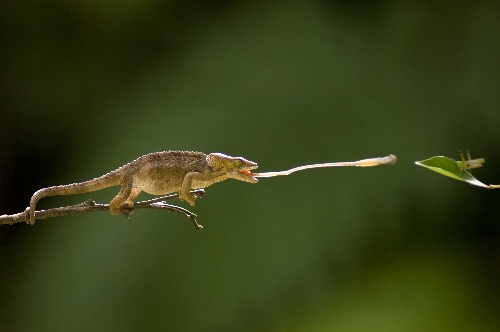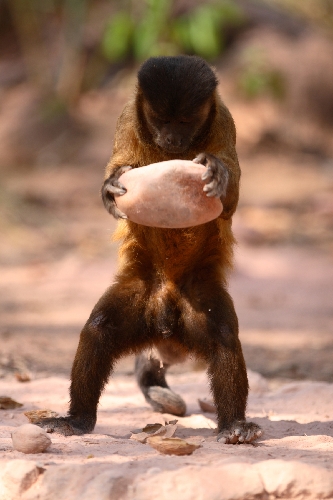Vivid scenes bring nature to ‘Life’ in breathtaking detail
Who needs Pandora when you've got Discovery Channel?
Over the next five weeks, the cable giant will showcase a dozen or more creatures that look like the sort of thing James Cameron would dream up, then spend the gross domestic product of a developing nation to bring to the big screen. The biggest difference: All of Discovery's critters are real.
Welcome to "Life" (8-10 p.m. today), the wildly ambitious 11-part follow-up to the beloved documentary "Planet Earth."
More than 3,000 days of filming. Seven continents. New camera techniques and technologies. All to bring you scenes from nature rarely, if ever, witnessed.
Take the panther chameleon of Madagascar, the Gene Simmons of the animal world, whose massive tongue unfurls, shooting out to rip an unsuspecting praying mantis or stick bug from a nearby leaf. When the insects' bewilderment is captured in slow motion, the action is nearly as comical as it is fatal.
Or the stalk-eyed fly of Malaysia, which, shortly after it's born, pumps air bubbles into the stalks supporting its eyes so they extend far from its head -- picture a steer with eyes on the end of its horns -- because the fly with the longest stalks gets all the ladies.
It's all brought to you in breathtaking detail, whether it's the panic in the eyes of a fly as it's swallowed up by a Venus flytrap, or the beating heart of a clownfish while it's still inside its egg. The cameras get so close, they make a Costa Rican strawberry poison-arrow frog, roughly the size of a fingernail, look like something that could level Tokyo.
And, like TMZ in pursuit of a Kardashian, there doesn't seem to be any place "Life's" cameras won't go. There's footage from inside a tiny pool formed in a leaf 100 feet up a tree. And there's an underwater shot looking up as a common basilisk, better known as a Jesus Christ lizard, sprints along the water's surface.
"Life" transitions straight from the 120-plus degrees of Africa's Namib Desert to frozen, 40-below Manitoba.
Cameras even capture a Komodo dragon wounding a much larger water buffalo, then follow it as dragons harass the beast around the clock for more than two weeks until it dies.
As in most nature documentaries, death is a part of "Life." Rooting for a button-cute, 10-day-old ibex as it tries to elude a fox by scampering up an almost sheer rock face isn't for the faint of heart. And if you're watching with young children, you might want to create some sort of distraction as soon as you spot a trio of cheetahs eyeballing an ostrich.
But skimping on harsh realities would mean deviating from "Life's" educational mission. At the end of the 11 episodes, you'll be able to entertain your friends by impersonating the kid from "Jerry Maguire." "Did you know the giant Pacific octopus can lay 100,000 eggs at once?" "Did you know polar bears can smell food from 20 miles away?" "Did you know the South Pacific sea crate mates for up to a day at a time?" Well, "entertain" might be stretching things, but you get the idea.
Mostly, though, "Life" exists to celebrate the beauty and wonder of, well, life. If watching the brown-tufted capuchin monkeys of central Brazil use a rock to hammer open a palm nut -- a skill that's far more involved than it sounds, and one that can take up to eight years to master -- doesn't elicit a deep, sustained "Awww," then I hate to be the one to tell you, but you're dead inside.
But the greatest gift of "Life" just might be the way it makes even the gnarliest of creatures seem beautiful. The Japanese mudskipper, the fish that drags itself around on land, leaps around to attract a mate and digs itself a home with its mouth only to emerge from its hole to spit up pellets of mud, is likely the most unexpectedly adorable thing you'll see all year. And watching a determined, 2-inch goby pulling its way 400 feet straight up the vertical rock face of a Hawaiian waterfall in search of a better life is downright inspirational.
"Life's" only real shortcoming is Oprah Winfrey's narration. Unlike the best voice-overs, you're always keenly aware you're listening to the daytime diva. I kept expecting her to introduce the animals as though they were guests on her talk show: "Please welcome, the ring-tailed leeee-murrrr!"
The script Winfrey was given is a little too cute and clunky at times, but it's nothing worse than the dialogue you'd hear in that other celebration of nature, "Avatar."
Best of all: You can experience all the beauty "Life" has to offer from the comfort of your living room, and without having to wear those goofy glasses.
Christopher Lawrence's Life on the Couch column appears on Sundays. E-mail him at clawrence@ reviewjournal.com.























